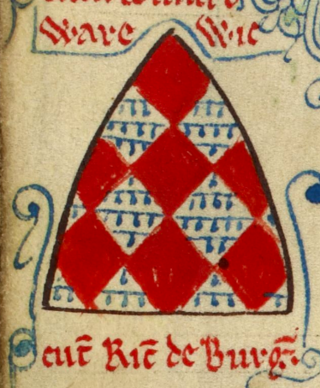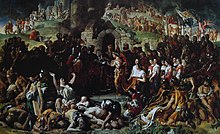
The Lord Mayor of Dublin is the honorary title of the chairperson of Dublin City Council which is the local government body for the city of Dublin, the capital of Ireland. The incumbent, since June 2024, is councillor James Geoghegan. The office holder is elected annually by the members of the council.

Roger Bigod was 5th Earl of Norfolk.

The House of Burgh or Burke was an ancient Anglo-Norman and later Hiberno-Norman aristocratic dynasty which played a prominent role in the Norman invasion of Ireland, held the earldoms of Kent, Ulster, Clanricarde, and Mayo at various times, and provided queens consort of Scotland and Thomond and Kings of England via a matrilineal line.

William de Burgh was the founder of the House of Burgh in Ireland and elder brother of Hubert de Burgh, 1st Earl of Kent and Geoffrey de Burgh, Bishop of Ely. William is often given the epithet, "the conqueror", but is not to be confused with the English king of the same nickname.

Richard Mór de Burgh, 1st Lord of Connacht, was an Anglo-Norman aristocrat who was Seneschal of Munster and Justiciar of Ireland (1228–32).

Walter de Burgh, 1st Earl of Ulster, 2nd Lord of Connaught also spelt Burke or Bourke, was an Irish peer from the House of Burgh.

William de Burgh, 3rd Earl of Ulster and 4th Baron of Connaught was an Irish noble who was Lieutenant of Ireland (1331) and whose murder, aged 20, led to the Burke Civil War.

The history of Ireland from 1169–1536 covers the period from the arrival of the Cambro-Normans to the reign of Henry VIII of England, who made himself King of Ireland. After the Norman invasion of 1169–1171, Ireland was under an alternating level of control from Norman lords and the King of England. Previously, Ireland had seen intermittent warfare between provincial kingdoms over the position of High King. This situation was transformed by intervention in these conflicts by Norman mercenaries and later the English crown. After their successful conquest of England, the Normans turned their attention to Ireland. Ireland was made a lordship of the King of England and much of its land was seized by Norman barons. With time, Hiberno-Norman rule shrank to a territory known as the Pale, stretching from Dublin to Dundalk. The Hiberno-Norman lords elsewhere in the country became Gaelicised and integrated in Gaelic society.
Sir Edmund de Burgh was an Irish knight and ancestor of the Burke family of Clanwilliam.

Walter de Lacy was lord of Meath in Ireland. He was also a substantial land owner in Weobley, Herefordshire, in Ludlow, Shropshire, in Ewyas Lacy in the Welsh Marches, and several lands in Normandy. He was the eldest son of Hugh de Lacy, a leading Cambro-Norman baron in the Norman invasion of Ireland, and Rohese of Monmouth.
Gilbert de Angulo was an Anglo-Norman knight, fl. 1195–1213. Proof of his very high Standing in the early years of Cambro Norman control of Ireland DUBLIN CHARTER OF ST MARYS, A.D. 1192 .55 ...DUBLIN REVENUE. 55 Dunestamuill; Willielmo de Kahaignes senescallo meo; Theobaldo Walteri, pincerna; Hamone de Valoniis; Ingel- ram de Pratellis; Dauide Wallensi; Ricardo de Ruuers; Folcone de Cantelleu; Willielmo, filio Ricardi; Gilleberto de Angulo; Rogero Tyrell; Magistro Benedicto; Magistro Petro Canuto. Apud London, regni Richardi, regis Anglie, anno tertio, quinto decimo die Maii. ... Charter of St Marys Dublin 260 C-0pr4eHARTULARY OF ST MARYS DUBLIN annum, Grant from qui hanc cartam scripsit, et totus Conventus; Rey St. Mary'sAbbey to mundus, constabularius; Comes Ricardus; Galfridus Alberic de de Costantin; Gocelýn de Angulo; Willelmus de Angulo; Adam de Futipone; Robertus de Brimeg ham; Willelmus, filius Henrici; Rogerus Foloue; Rogerus Tirel; Ricardus Golofer; Alajn, filius Hamonis; Ricardus de Dere; Willelmus de Brimeghem; Circa 1176. iv. Memorandum quod Ricardus Comes premisit Raymund Reymundum in Hyberniam, in auxilium Dermetii, ante le Gros. 270 CHARTULARY OF ST MARYS DUBLIN Charter to tam nostram inde extra muros usque ad predictas Dublinfrom Testibus: Stephano Rýdello, cancellario meo; Waltero fol. 87 a. parte folii de Dunstamvile; Willelmo de Kahaygnes; Senescallo sequentisquod Jomeo; Theobaldo Walteri, Pincerna; Hamundo de hannes ad-Waloniis; Ingellam de Pratellis; David Walon; Ricardo factus es de Riveres; Fulcone de Cantelou; Willelmo, filio Ri set Rex. cardi; Gilberto de Angulo; Rogero Tyrell; Magistro Benedicto; Magistro Petro Canuto. Apud London, A.D. 1192. regni Ricardi, Regis Anglie, anno tercio, quinto decimo die Maii.

Jonquerets-de-Livet, also Les Jonquerets-de-Livet, is a former commune in the Eure department in Normandy, France. On 1 January 2016, it was merged into the new commune of Mesnil-en-Ouche. It incorporates the village of Livet-en-Ouche, once known simply as Livet.

Levett is a surname of Anglo-Norman origin, deriving from [de] Livet, which is held particularly by families and individuals resident in England and British Commonwealth territories.

The Book of the de Burgos or Book of the Burkes is a late 16th-century Gaelic illuminated manuscript held by the Library of Trinity College Dublin as MS 1440, Historia et Genealogia Familiae de Burgo. The book consists of seventy-five folios, twenty-two of which remain blank.
Egidia de Lacy, Lady of Connacht, was a Cambro-Norman noblewoman, the wife of Richard Mór de Burgh, 1st Baron of Connaught and Strathearn (c.1180–1242), and the mother of his seven children, including Sir William Óg de Burgh, a lord and warrior and Walter de Burgh, the first Earl of Ulster. She was also known as Gille de Lacy. Egidia was the daughter of Walter II de Lacy by his second wife Margaret de Braose.

William Levett was lord of the manor of the South Yorkshire village of Hooton Levitt, a village named in part for his ancestors, and became the owner of the patronage of Roche Abbey on marriage to the granddaughter of the Abbey's cofounder Richard FitzTurgis, a Norman baron who co-founded Roche with the great-nephew of one of England's most powerful Norman barons, Roger de Busli.
Thomas de Clare, Lord of Thomond was an Anglo-Norman peer and soldier. He was the second son of Richard de Clare, 6th Earl of Gloucester and his wife Maud de Lacy, Countess of Gloucester. In 1272 he served a term as Lieutenant of the Duchy of Aquitaine. On 26 January 1276 he was granted the Lordship of Thomond by Edward I of England; he spent the next eight years attempting to conquer it from the O'Brien dynasty, kings of Thomond.
The Priory of All Hallows was a monastic foundation just outside of the walls of Dublin, Ireland.

Mac William Íochtar, also known as the Mayo Burkes, were a fully Gaelicised branch of the Hiberno-Norman House of Burgh in Ireland. Mayo covered much of the northern part of the province of Connacht and the Mac William Íochtar functioned as a regional king and received the White Rod. The title was a successor office to the Lord of Connacht which ended upon the assassination of William Donn de Burgh, 3rd Earl of Ulster, in June 1333.

Richard Óg de Burgh, 2nd Earl of Ulster and 3rd Baron of Connaught, called The Red Earl, was one of the most powerful Irish nobles of the late 13th and early 14th centuries and father of Elizabeth, wife of King Robert the Bruce of Scotland.












